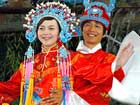| Videos | ? Latest |
|
? Feature | ? Sports | ? Your Videos |
Change of 60 years Chinese culture
From the limited past time enjoyments of decades ago, China's cultural and entertainment scene has moved into a phase of countless forms and dazzling colors. From books and a TV set as every family's only entertainment, people nowadays can enjoy themselves with portable gadgets, on the subway, on a bus, in the office, or in their own living room. Various media has offered people many options for relaxation and fun.
On today's first episode of the Series, we'll have a brief review to see how the cultural life of Chinese people has changed drastically over the sixty years.
Cultural life reflects the change of society with its rich and enchanting visage. From local operas, film, and music, to the fashion and hair styles of people, sixty years of time have witnessed the evolution of every aspect of Chinese people's cultural life.
1950s
The first big cultural activity of New China was the founding ceremony of the People's Republic of China on October 1st, 1949. Since then, Tian An Men Square has become a landmark for large scale gatherings.
The most popular entertainments for Chinese people include fireworks displays, art shows, and public gatherings. People receive inspiration and feel great joy among the cheering crowds. Yangge performance and stilt walking became popular shows. Chinese people liked to immerse themselves among the carnival groups, in which they experience an inspiring spirit of unity.
Filmmakers burst into new enthusiasm to create brand new works. In 1959, the ten-year anniversary of the founding of New China, Chinese filmmakers made a record number of movies within the past decade.
Examples include the biopics "Lin Ze Xu", and "Nie Er", the war pictures "Fight in Shanghai", "Seeking bandits in Desert", and films reflecting people's life "Five Daughters", "Sisters on Ice" and "Youngsters in Our Village". There were also films adapted from literary classics such as "Lin Family Shop" and "The Song of Youth". Screen idols Zhao Dan, Xie Tian, Jin Shan, Xie Fang became admired by millions.
1960s-1970s
The Chinese people experienced difficult time during the 1960s to 1970s. The natural disaster during the first three years in the 1960s led to famine in the country. And the Cultural revolution during mid 1960s to 1970s brought a turbulent era to Chinese people, which left a wound in the hearts of the people.
However, during the Cultural Revolution, an era dubbed as a "cultural desert", there were eight plays widely performed on the country's stages. Collectively, they are known as the Yang Ban Xi, or the eight model plays. They feature revolutionary themes and larger-than-life heroes and heroines. The eight plays became Chinese people's main entertainment.
They include Peking operas "The Legend of Red Lantern", "Sha Jia Village", "Taking Tiger Mountain by Strategy", "The Harbor" and "Raid on the White Tiger Regiment", the ballets "The Red Detachment of Women", and "The White Haired Girl", and the symphony "Sha Jia Bang".
Although the eight plays dominated Chinese people's cultural life, and were mainly created for political purposes, they achieved high artistic standards because they were perfected by artists after much polishing.
The plays sought inspiration from traditional Chinese operas and took cues from western stage design and play structure. Such as in the Peking Opera pieces, they changed the abstract stage design typical of the Peking Opera tradition into real material settings typical of western plays. The pieces also creatively used a symphony orchestra to accompany the Peking Opera singing. The narrative also followed a western play format, which was more compact, and led to more powerful dramas.
At the end of the 1970s, when the Cultural Revolution ended, Chinese cinema and music saw a rejuvenation. Film "Ba Shan's Night Rain" and "Legend of Tian Yun Mountain" are representative works. These films reflect filmmakers' seriousness about the past turbulent era. While movies "Little Flower" and "Longing for Returning Home" were fine examples of how to portray beautiful minds and moving feelings.
At the end of the 1970s, taking a bench to watch a film outdoors in the open air after dinner became the most enjoyable thing for Chinese people to do.

 0
0 






